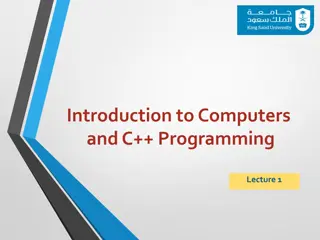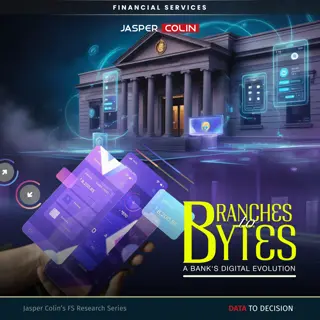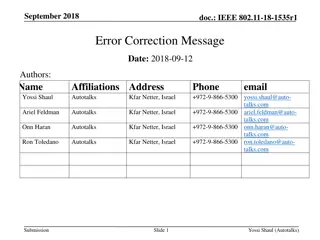Understanding Memory Units in Computing
Memory units are essential components in computing devices that store binary information in words, allowing for fast and efficient data retrieval. They consist of storage cells, circuits, and address selection lines for communication. Random Access Memory (RAM) enables quick access to data, while Re
6 views • 15 slides
Solving Fitch's Paradox of Knowability Using Fractal Mathematics
Explore how to tackle Fitch's Paradox of Knowability through the use of fractal mathematics, DSI (Deterministic Search of Infinity) algorithm, and interstellar data compression. By understanding the scopes of knowability and employing innovative solutions, such as compressing massive amounts of data
0 views • 9 slides
Understanding Data Addressing Modes in System Programming
Introduction to fundamental data types in Intel architecture including bytes, words, double words, and quad words. Explanation of specifying an offset in memory with examples of instruction descriptions. Overview of data addressing modes such as register addressing and immediate addressing in system
1 views • 15 slides
Understanding Computer Systems: Components and Organization
Computer systems are high-speed electronic machines that process data and instructions through hardware and software components. The elements include hardware, software, and users, with binary systems using bits and bytes to represent data. The organization of a computer involves input, CPU, memory,
1 views • 21 slides
Understanding Data Representation on Computer Systems
Explore how data is converted into binary forms in computer systems, the difference between data and information, binary coding schemes, and the elements of the data hierarchy. Learn about binary digits, bites, bytes, and the essential topics covered in this educational session. Recommended reading
3 views • 25 slides
Bits Bytes | Kiosk Manufacturer In India | Touch Screen Kiosk India
Are you looking for the best kiosk manufacturer in India? we at Bitsbytes, we dedicated genuine & customized kiosk solution at an affordable cost with installation unit. Hire our experienced & professional kiosk manufacturer in India with no hidden c
1 views • 8 slides
Introduction to Computers and C++ Programming Lecture 1 - Overview and Basics
This lecture covers the fundamental concepts in computer systems and programming using C++. Topics include the main components of a computer, bytes and addresses in memory, computer systems hardware and software, understanding programs, programming languages, compilers, preparing and running C++ pro
1 views • 21 slides
Understanding TCP and UDP in Computer Network Interoperability
The Transport Layer in computer networks facilitates logical communication between application processes on different hosts. Two key transport protocols, UDP and TCP, provide distinct services - UDP offers unreliable and unordered delivery, while TCP ensures reliable and ordered delivery with featur
1 views • 9 slides
Overview of SMX Algorithm and AES Encryption Standard
The SMX Algorithm presents a fresh approach to the avalanche effect in the Advanced Encryption Standard (AES). Initially developed to overcome the limitations of the Data Encryption Standard (DES), AES boasts improved security and efficiency, supporting key lengths of 128, 192, and 256 bits. The AES
3 views • 19 slides
Understanding Basics of Computer Systems
A computer is an electronic device that stores and processes data using hardware and software components. It consists of a CPU, memory, storage devices, input/output devices, and communication devices. The CPU includes a Control Unit and Arithmetic Logic Unit, and the memory stores data in bytes. St
0 views • 57 slides
Understanding Byte, Endianness, and Memory Addressing in Computer Systems
Delve into the intricacies of bytes, endianness, and memory addressing in computer systems through information on gdbserver installation, binary representation, ASCII encoding, byte sizes, and memory address allocation. Explore the fundamentals of data representation and manipulation to enhance your
0 views • 47 slides
Summary of MAC Address Policy Contribution to IEEE 802.11
This document outlines the contribution of MAC address policy to IEEE 802.11, focusing on defining ANQP and Beacon elements to convey information about addressing types supported by the network. It details how specific bits in the ANQP element represent support for various MAC address types includin
0 views • 5 slides
Wireshark Data Capture and UDP Analysis
Capturing data flow through packets in Wireshark reveals a series of fragmented payloads, starting with a leader packet of 44 bytes and ending with a trailer of 24 bytes. The UDP data payloads range from 44 to 1372 bytes, with specific lengths for different payloads and packets. Analysis includes UD
0 views • 4 slides
Project Team Presentations and Data Visualization Projects
Project Team Presentations involve groups like 5Guys, BleacherReport, Bytes & Bars, CHAJ, and more working on COVID-19 data analysis and volleyball statistics visualization. The teams are tasked with tasks ranging from background research to creating interactive maps and charts, with a focus on unde
0 views • 59 slides
SPC Algorithm: Shift-based Pattern Matching for Compressed Web Traffic
Victor Zigdon presents the SPC Algorithm, a simpler and more efficient approach to pattern matching in compressed web traffic. By applying an accelerating idea on pattern matching algorithms, the SPC Algorithm skips bytes and achieves throughput improvements. The background includes information on G
0 views • 21 slides
Understanding Binary Encodings and Internet Communication
Learn about binary encodings, sending data over the internet, bytes, hexadecimal representation, and character encoding in this informative content. Dive into the basics of representing information digitally and discover how to communicate effectively in the digital world.
0 views • 33 slides
Exploring Carnegie Mellon's Introduction to Computer Systems
Delve into the world of computer systems with Carnegie Mellon University's System-Level I/O course, covering concepts such as file operations, Unix I/O, and kernel data structures. Learn about standard I/O, handling I/O devices as files, and understanding the sequence of bytes in a file. Discover th
0 views • 53 slides
Understanding Number Systems and Codes in PLC
Delve into the world of number systems and codes in Programmable Logic Controllers (PLC) with a focus on decimal, binary, octal, and hexadecimal systems. Learn how data is represented and manipulated in PLC applications through various numeric systems and codes. Explore the significance of bits, byt
0 views • 12 slides
Understanding ICT Systems in Everyday Life
Explore the basic components of a computer system, including the processor, internal memory, input/output devices, and storage, with a focus on how computer systems function in daily life. Learn about computer monitors, the role of operating systems, RAM and ROM memory types, cache memory, and how c
0 views • 130 slides
Understanding Multitasking and Exceptional Control Flow in Computer Systems
Explore the intricacies of multitasking and exceptional control flow in computer systems as taught in Carnegie Mellon's 15-213/18-213 course. Delve into topics like signals, nonlocal jumps, bits, bytes, integers, floats, assembly, stack discipline, cache linking, process context switch, hardware tim
0 views • 44 slides
Understanding Binary Operations and Bitwise Manipulations in Programming
Exploring topics such as integers, bits, bytes, bitwise operators, signed vs. unsigned numbers, binary-hexadecimal conversion, and practical exercises to grasp essential concepts in computer programming.
0 views • 73 slides
Branches to Bytes- A Bank's Digital Evolution
Want to know how we helped them boost revenue by 15%, improve customer retention by 10%, AND slash costs by 9% in just two years?
2 views • 6 slides
IEEE 802.11-18-1535r1 Error Correction Method for High Utilization Networks
This document discusses the implementation of a dedicated error correction packet in IEEE 802.11-18-1535r1 for improving error corrections in high utilization networks. The method involves sending parity bytes immediately after the original data packet, separated by Short Interframe Space (SIFS). By
0 views • 15 slides






















